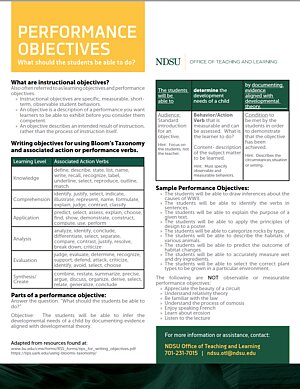Course Design
Good course design is an important part of any class. Teaching often presents special challenges, but also provides opportunity for broadening student horizons, incorporating diverse learning materials, and tailoring information to the individual. The course design section of our faculty resources will explore some fundamental concepts and considerations of what your students will learn when preparing your curriculum.
On this page we have collected information that will assist you in producing a well-designed curriculum.
For those who would like a little more guidance, we suggest you review the LAIC Instructional Design Resources page, or set up a consultation with one of our Instructional Coaches.
Learn more about instructional resources that cover how your students will learn the material. (this content is in development)
Course Design as a Process
Offering a new course first starts with planning and design. Instructional design could be defined as the systemic activity of 1) identifying the needs of learners and instructional goals, 2) matching those with an appropriate approach and vehicle for delivering course materials, and 3) the development of the assessments that measure the degree of learning and the quality of the instructional content.
There are numerous instructional design models from which to choose; the model presented here is based loosely upon the principles of the ADDIE model:
- Analyze the learner;
- Design learning objectives and outcomes;
- Develop instructional materials;
- Implement, or deliver, the instructional materials; and,
- Evaluate the quality of learning and instruction.
If you are looking for another instructional design model to compare with, a good site to visit is Carnegie Mellon University's Eberly Center. This site has a user-friendly resource section which includes information on Designing Your Course, Writing a Syllabus, and Teaching Your Course.
Although each course is unique, there are five general steps to follow. Continue reading to learn about all 5 steps.

Step 1: Learner Analysis
While all instructional and training materials have a common goal - to impart knowledge to the learner - the target audience and purpose of every project is unique. It is important to focus on the learner from the beginning of any development process. The information should be tailored to the abilities and needs of the learner. Further, consider the purpose of the material.
Addressing the following questions can assist in successful analysis of the learner:
- Who is the learner?
Describe the average person for whom the material is intended. Is that person a homemaker who is learning how to use the computer for the first time or a specialized technician? Careful consideration of the target learner can mean the difference between information that is engaging and helpful, or inappropriate and confusing. - What is the learner's level of pre-existing knowledge about the subject?
Gear the material to the appropriate knowledge level. Does that person possess a high level of advanced education on the subject or will the material comprise that person's first exposure to the subject? If concepts are new to the learner, more attention to building a foundation for concepts and definition of specific vocabulary will be required. - What is the learner's expected reading level?
Write to the expected reading level of the learner. Written material designed for children will be less challenging than training material written for practicing doctors. Of course, the use of standardized spelling and grammar is especially key when writing for an audience for whom English is not a native language. - What will the learner gain from the information?
One good strategy is to develop a detailed outline of the information that is to be covered, prior to course development. This outline can later serve as a guide to keep the content developer on topic and provide a guide for establishing learning outcomes or objectives. - What is the final format of the information?
Consider carefully how the information will be used or in what form it will be presented to the learner. Will the learner be reading the information on screen, juxtaposed with other media such as images or video? Will the information appear in paragraph form or as bullet points? Is the information the main content of the viewable screen, or is it attached by a link to the main content? Will the content be read aloud by a narrator? It is essential to the success of the development process to carefully consider how the information fits into the project as a whole.
The following passages demonstrate how the same subject matter might be presented to two different target audiences.
Target Audience - 8th Grade Anatomy Student:
Most deaths from heart attacks are caused by ventricular fibrillation. Ventricular fibrillation is the term used to describe the interruption of the normal beat of the heart, which pumps oxygen-rich blood to other parts of the body. When the heart stops beating, other parts of the body begin to starve for oxygen. This oxygen starvation causes injury, especially to the brain. If a heart attack victim can receive emergency medical care quickly, he or she has a very good chance of survival.
Target Audience - Medical Student:
Most deaths from myocardial infarction are the result of ventricular fibrillation. For those patients who receive immediate emergency room medical care, the prognosis exceeds 90%. Delayed mortality will occur in 1% to 10% of cases.
Although these passages cover approximately the same information, the latter is written at a more challenging vocabulary level. Further, the college-level example assumes that the learner is already somewhat familiar with the subject, as the writer makes no attempt to explain the cause-effect relationship.

Step 2: Scope and Sequence
As previously mentioned, one good strategy is to begin with an outline of the entire training series or course. Flesh out the details as much as possible, including section breaks or divisions, main topics and subtopics. This outline can also serve as a guide and a parameter for development of learning objectives. Learning objectives should match the course outline.
Addressing the following questions can assist in successful development of a course outline:
- What is the entry point into the subject?
It will be especially important to take all of the information gained from a learner analysis into consideration. The "beginning" of any course or training program will depend upon the prior expertise of the learner. - How important is this topic/subtopic?
The goal is to address the inevitable question before it is asked: Why do I have to learn this? The best training and educational programs successfully integrate content with learning objectives and assessment. In such environments, the learner can identify the expectations, can identify what topical ground will be covered, and has a sense of how he or she will be expected to demonstrate learning. If a particular topic is extraneous or if the learner will never be tested on the information, it may not be needed, or belong in a supportive or appendix area of the course. Conversely, if a topic is important, consider formalizing its importance with appropriate learning objectives and assessments. - What is the exit point from the subject?
As important as beginning a training or subject is the smooth transition out of the course; some options include summarizing the information or providing access to follow-up resources.

Step 3: Developing and Publicizing Learning Objectives
Learning objectives are explicit statements about what the learner is supposed to gain as a result of exposure to the course. Learning objectives should be concise and measurable. Whether stated formally or informally, it is important to identify those goals that you have for your students or trainees. In an online environment, it can be especially helpful to clearly communicate these objectives; these will serve as a both a support and a bar. Students will know what to expect from the content, and students will also know what is expected of them as learners. Additionally, effective objectives can guide curriculum development.
What are instructional objectives?
Also often referred to as learning objectives and performance objectives.
- Instructional objectives are specific, measurable, shortterm, observable student behaviors.
- An objective is a description of a performance you want learners to be able to exhibit before you consider them competent.
- An objective describes an intended result of instruction, rather than the process of instruction itself.
Learning Level | Associated Action Verbs |
|---|---|
| Knowledge | define, describe, state, list, name, write, recall, recognize, label, underline, select, reproduce, outline, match |
| Comprehension | identify, justify, select, indicate, illustrate, represent, name, formulate, explain, judge, contrast, classify |
| Application | predict, select, assess, explain, choose, find, show, demonstrate, construct, compute, use, perform |
| Analysis | analyze, identify, conclude, differentiate, select, separate, compare, contrast, justify, resolve, break down, criticize |
| Evaluation | judge, evaluate, determine, recognize, support, defend, attack, criticize, identify, avoid, select, choose |
| Synthesis/ Create | combine, restate, summarize, precise, argue, discuss, organize, derive, select, relate, generalize, conclude |
Parts of a performance objective:
Answer the question: “What should the students be able to do?”
Objective: The students will be able to infer the developmental needs of a child by documenting evidence aligned with developmental theory.
The students will be able to | determine the development needs of a child | by documenting evidence aligned with developmental theory. | ||
|---|---|---|---|---|
Audience: Standard introduction for an objective. Hint: Focus on the students, not the teacher. | Behavior/Action Verb that is measurable and can be assessed. What is the learner to do? Content- description of the subject matter to be learned. Hint: Must specify observable and measurable behaviors. | Condition to be met by the students in order to demonstrate that the objective has been achieved. Hint: Describes the circumstances, situation or setting. |
Sample Performance Objectives:
- The students will be able to draw inferences about the causes of WWII.
- The students will be able to identify the verbs in sentences.
- The students will be able to explain the purpose of a given text.
- The students will be able to apply the principles of design to a poster.
- The students will be able to categorize rocks by type.
- The students will be able to describe the habitats of various animals.
- The students will be able to predict the outcome of habitat changes.
- The students will be able to accurately measure wet and dry ingredients.
- The students will be able to select the correct plant types to be grown in a particular environment.
The following are NOT observable or measurable performance objectives:
- Appreciate the beauty of a circuit
- Understand relativity theory
- Be familiar with the law
- Understand the process of osmosis
- Enjoy speaking French
- Learn about erosion
- Listen to the lecture
In general, your learning objectives will be most helpful to you in developing assessments, and most clearly convey your intentions to your students if you use specific, measurable, action words to describe outcomes.
Example Learning Objective: In this lesson, you will learn about the area of regular polygons.
Better Learning Objective: After you complete this lesson, you will be able to calculate the area of a regular polygon when given information about its dimensions.
The word "calculate" in the second example indicates both to you and the learner that he or she will be expected to actively demonstrate mastery of this calculation.
Printables
Writing Course Objectives
Use this printable for assistance in writing course objectives.
View in PDF | Audio (MP3) >>
Performance Objectives:
What should the students be able to do?
Use this printable to assist you in writing performance objectives for your class.
View in PDF | Audio (MP3) >>
More Resources for Developing Effective Objectives:
- NDSU Intended Student Outcomes for General Education https://bulletin.ndsu.edu/academic-policies/undergraduate-policies/general-education/#learningoutcomestext
- Resources from the Faculty Innovation Center at the University of Texas at Austin covers a wide array of topics relevant to college-level educators.
- A Quick Guide to Writing Learning Objectives. Includes templates for formulating objectives quickly.
Tip:
It is possible that as you develop learning objectives, you may wish to modify your course outline. The converse is also true. Course design is an iterative process; in an effective course, all course elements work together and so it is reasonable to expect that as one aspect of the design takes shape, it will affect the shape of other elements of the course.
Publicizing Learning Objectives
Once learning objectives have been developed, publicizing them can be as simple as listing them in conjunction with each portion of the content as part of an introduction. This site provides an example of one way to publicize your expectations for your students. Here are some others:
- Provide a non-graded pre-test as an introduction to each content section or unit. The questions will serve as clues to the learner about what topics will be covered and what information the instructor considers important.
- Garner student input regarding course content options. Ask students to list what they hope to learn about the subject or field. Use a discussion board or chat session to solicit group interaction. Incorporate these expectations into the course design and tell students which suggestions will specifically be addressed.

Step 4: Selecting the Mode of Delivery
Powerpoint presentation or text on screen? Audio narration or printed words? Animation or slide show? Once you have clarified the course outline and developed learning objectives, production of actual course products can begin. How you plan to distribute the information will determine how you develop the information.
Use these questions as a guide for determining what mode of delivery is best for your course:
- How independently will learners make use of the information?
The more oversight of the course and student activity you as the instructor plan to provide, the less automated the software and course site will need to be. Conversely, the less human involvement and oversight you plan to incorporate into the course site, the more independently learners will work, and the more automated the course software will need to be. In this latter case, the software will need to take the place of the instructor; all of the teaching elements will need to be provided by the system. Consider this continuum of delivery complexity, as pictured below. - What are the technological needs and limitations of the learners?
The answer to this question may warrant a revisitation of your learner analysis. For most course media considerations, this will largely come down to the quality of Internet access and the limits of the personal computer afforded to the average learner in your course. Those with high quality Internet access and well-equipped computers will generally be able to participate in media-intensive course information, including streaming audio, video and interactive communication sessions. By contrast, if the average course participant will be accessing the course website through a standard phone line, streaming audio or video may not be feasible. In such a scenario, it may be optimal to provide course media on a CD or DVD that is provided by mail to learners prior to accessing the course site.
As important, don't forget to account for course accessibility to those with disabilities. For example, those with hearing impairment cannot consume audio content as readily. Couple images and sound with descriptive text-based information to fill in any gaps. Even those learners without disability will benefit from receiving information in multiple forms; in this way, learners may see and hear, which reinforces learning. - What are the technological limitations for course media development for you as the instructor, in terms of resources and budget available?
The more involved you plan to be in the individual learning activities and assessments of your students, the less complex materials may need to be - as previously addressed. In such a case, a well-notated PowerPoint along with live chat sessions may be appropriate, developed with relative ease, and not require any access to specialized equipment, software, technical personnel, or training. A fully automated learning environment, such as that required for independant coporate training, may require the development of streaming audio, streaming video, animations, and automated entry and exit features. Consider the possible need for access to specialized equipment, software, and technical personnel. - What is the timeline/deadline for the course offering?
The more complex the design and automation of the system, the more time it will take to implement finished course products. When planning out a timeline for project completion, do take the following into consideration: time needed for content experts to draft materials, time needed for materials to be translated into a working storyboard (in the event of automated course product development), time needed for development of prototypes or drafts of working models, time needed for proofing and revision, and time needed for follow-up testing and rollout.
The Power of Asynchronous to Improve Learning
Are you interested in teaching an online asynchronous class? Or have you tried teaching an asynchronous online class but were unhappy with the results? This session will cover the basics of teaching an asynchronous class. Topics will include organizing the structure of the asynchronous class for less frustration and more learning, encouraging student engagement, and creating assessments that work well in the asynchronous environment.
Continuum of Delivery Complexity
| No Instructor Oversight / Learner Independence | Instructor Oversight / Learner Dependence | |
| <------------------------ | ------------------------> | |
| Complexity of Automation / Computer Assisted Learning | No Automation / Human Intervention |
Tip: Need some experts at your disposal? Want assistance with the Instructional Design process? Need an expert to help you record audio files? Check the "Resources" section for links to experts right here on the NDSU campus!

Step 5: Assessment and Evaluation
Last, but certainly not least, it is important to determine not only the benefit to the learner as a result of interacting with the course, but also the course itself.
In terms of course design, consider the following:
- How will course objectives be assessed or evaluated?
- At what points along the course path will learners engage in assessment or evaluation activities?
- Will progression through the course materials be mitigated by assessment or evaluation completion or performance level?
- How will students receive feedback about assessment or evaluation performance?
- How will course quality be assessed or evaluated?
- What aspects of the course will be considered as part of assessing or evaluating course quality (e.g. student matriculation and completion, student satisfaction, student achievement)?
Consider preparing and administering a midterm feedback questionnaire in your classes. It can be simple.
View sample questions >>
View midterm feedback template >>
Video Resources
Best Practices for Incorporating Video in the Online Course Environment
Covers the benefits of including video in an online course, and demonstrates best practice techniques on how to create and prepare video presentation files for online course delivery that are engaging and user friendly for students.
High- and Low-Tech Tools for Student Engagement and Rapid Feedback in Large Lecture Courses
While not a new practice, the effective and efficient use of voting devices within a course is challenging. Drs. Tara Slominski and Warren Christensen will bring their knowledge of research literature and their combined 24 years of experience to discuss the use of these formative assessment strategies.
Incorporating Wellness in Course Design
Understand a common wellness model and explore ways to incorporate wellness in the course through assignments and in-class practices.




